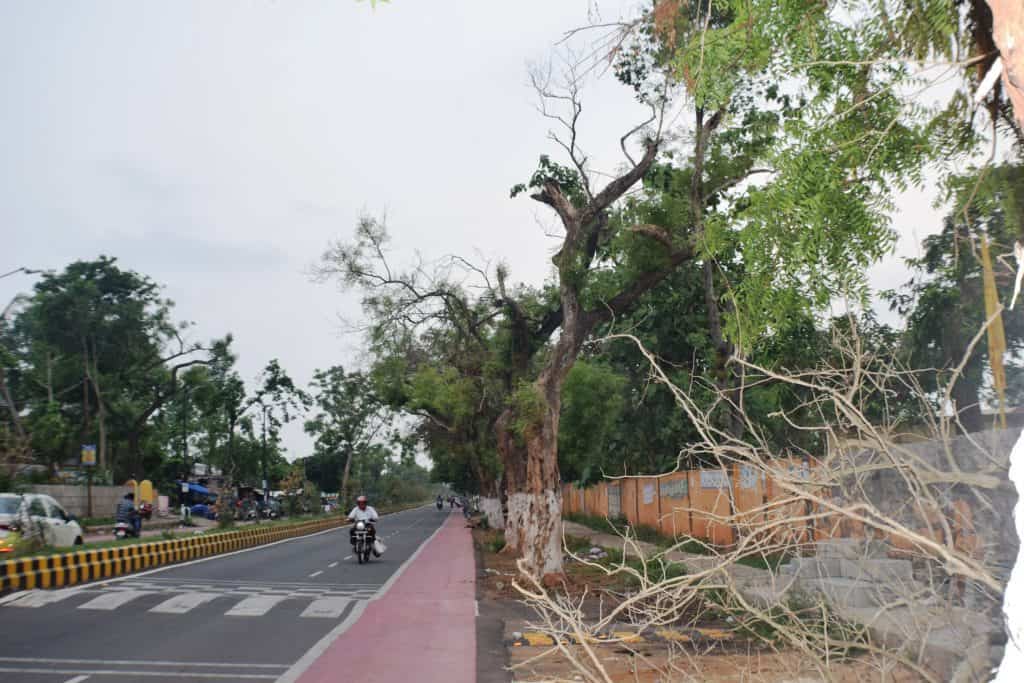One morning, nearly a month after Cyclone Fani struck Odisha, Ashok Baral, a citizen of Bhubaneswar, came upon a fallen trunk of a banyan tree near the Stewart School boundary wall. The tree had been uprooted by the cyclonic storm Fani, which hit the city on May 3, 2019. Recalling that particular moment, Ashok says, “Though it was my regular route home from the milk vendor, it seemed as if the helpless trunk of the tree was trying to tell me something on this particular day. I stayed there, looked at the trunk for some time, and wrote a message to the forest and environment secretary immediately after I came back, on behalf of the tree, requesting him to restore it at the place where it existed before.”
Ashok’s attempts were not in vain and the tree was restored by the forest department the same night. “I sense a feeling of contentment now when I see the trimmed trunk coming to leaf,” he says, adding that the Smart Citizen Forum, of which he happened to be a member, had similar plans to plant one lakh trees in the city to bring back the green cover that the city lost in the cyclone.
There are other stories of restoration around the city. Of more than one lakh trees uprooted by the very severe cyclonic storm Fani in the city of Bhubaneswar, over 9000 big and mid-sized trees have been restored so far by the forest department, with the support of volunteers from various non-government organizations (NGOs) in some cases, according to Ashok Mishra, Bhubaneswar City Divisional Forest Officer (DFO).
“In collaboration with the forest department, we and our 120-member green army of volunteers have restored more than 2000 uprooted trees in different parts of the city,” shares Shweta Agarwal, an architect and founder of the Bhubaneswar-based Unmukt Foundation.
Building resilient green cover
With the green cover in the city almost completely destroyed by Fani, the city of Bhubaneswar is now looking at planned efforts to bring back the trees, especially those that can withstand heavy cyclonic wind and help the city combat all kinds of heat stress. Shweta, too, confirms this.
Raising alarm over the fact that “cyclones are likely to be more frequent in the near future in the current scenario of global warming and Odisha’s vulnerability to climate change,” environmentalist Professor Radhamohan also called for planting cyclone resilient trees to ensure long term green cover.
But what are cyclone resilient trees? Experts such as botanist- conservationist Hemant Kumar Sahoo and Radhamohan say that species like Neem, Patali (Bignoniaceae), Saptaparni (Alstonia), Putranjiva roxburghi, Badam (Indian Almond), Arjuna (Terminalia arjuna), Jamun (Malabar plum or black plum), Kusum (Ceylon oak or Lac tree), Oou (elephant apple), Sunari (Golden Shower or Indian laburnum), tamarind, Acacia Mangium, Chironjee, Champak and Kanchana or Kachnar should be considered for avenue plantation in view of cyclone resilience. Besides, species like cashew, casuarina, acacia auriculiformis, Shishoo (North Indian rosewood), bamboo, American Silk Cotton can be considered for commercial plantation.
Based on his observations and a survey he conducted in the city, botanist Sahoo emphasized on planting saplings of wind resilient, resistant and tolerant varieties of trees so that they can withstand the heavy wind, re-grow even after damage and adapt to the changing climatic conditions.
Plans for massive plantation
In order to bring back the lost green cover, “massive plantation through convergence mode is the need of the hour,” says Jagadananda, founder of the Centre for Youth and Social Development (CYSD), a non-profit, and pioneer of the forum named Civil Society Responds to FANI (CSRF). This requires collective action by the government, civil society organizations, community-based organizations and corporate bodies.”
“The forest department has plans to plant about one lakh saplings, of which 60000 will be of big and strong tree varieties to be planted alongside the roads. Other than the forest department, Bhubaneswar Development Authority (BDA) will look after restoration of green cover in parks and Bhubaneswar Municipal Corporation (BMC) shall participate in the city plantation drive, said City DFO Ashok Mishra.
While plantation drives are welcome and much-needed, experts apprehend that the stiffer challenge ahead of the forest department will be producing and procuring adequate number of saplings of resilient trees.
However, “keeping in view the dearth of disaster-resilient saplings in the state, the government has planned to seek support from neighbouring states,” said Sandeep Tripathy, Principal Chief Conservator of Forest (PCCF), while speaking on the government roadmap for restoration of green at a consultation meeting organised by CSRF.
Diversity needs attention
Green cover restoration efforts mustn’t be limited to checking resilience and resistance. It also needs to have the diversity it had before. “We need to plant fruit bearing plants and other species that have a role in food security too,” says Shweta, highlighting that her foundation has started a programme to plant one thousand fruit bearing trees in different school premises in the city. “After schools, we will expand it to the rest of the cityscape, more specifically in the bald spaces of the city and its outskirts.”
As suggested by botanist Sahoo, plantation of moringa and papaya plants in the backyard and front yard of the houses of poor people could be promoted, so as to ensure natural food supply. While speaking on the departmental plans, DFO Mishra said, “The green cover shall comprise diverse vegetation.”
“We need to seek inputs from the tribal communities who know the forest better and so, can plan the afforestation better, ensuring that all native species form part of the urban forest,” said Shweta. “We should make the best use of their knowledge of plants and forest ecosystem.”
The entire programme of regreening Bhubaneswar is therefore a massive one involving a huge number of stakeholders. The enthusiasm and participation are encouraging. However, Prasanna Mishra, a city veteran and retired IAS, makes a moot point as he says, “Proper implementation and strict monitoring will finally be key to ensuring the desired results.”
